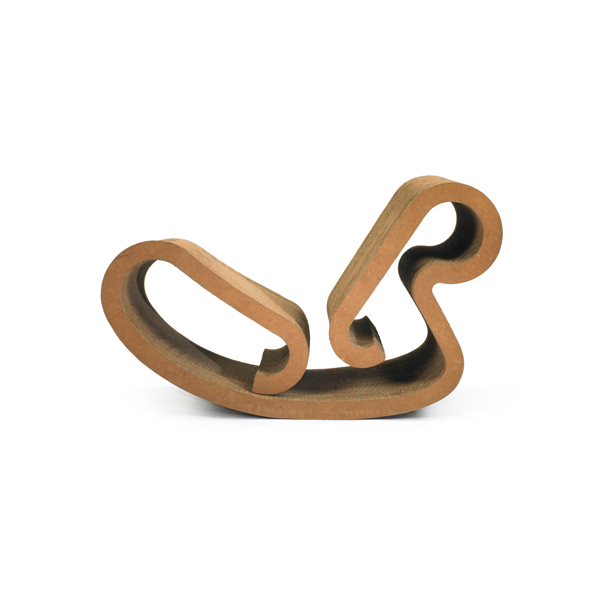[av_slideshow_full size=’no scaling’ stretch=” animation=’fade’ autoplay=’false’ interval=’5′ control_layout=’av-control-default’ src=” attachment=” attachment_size=” position=’top left’ repeat=’no-repeat’ attach=’scroll’]
[av_slide_full slide_type=’image’ id=’60277′ video=” mobile_image=” video_format=” video_ratio=” title=’Frank Gehry Furniture’ custom_title_size=’48’ custom_content_size=’20’ caption_pos=’caption_center’ link_apply=” link=’lightbox’ link_target=” button_label=” button_color=’light’ link1=’manually,http://’ link_target1=” button_label2=” button_color2=’light’ link2=’manually,http://’ link_target2=” font_color=’custom’ custom_title=’#ffffff’ custom_content=’#020202′ overlay_enable=’aviaTBaviaTBoverlay_enable’ overlay_opacity=’0.1′ overlay_color=’#444444′ overlay_pattern=” overlay_custom_pattern=”]
BY KARLA KLEIN ALBERTSON
[/av_slide_full]
[/av_slideshow_full]
[av_textblock size=” font_color=’custom’ color=’#ffffff’]
Frank Gehry designed the Easy Edges series of corrugated cardboard furniture before he achieved worldwide recognition for his architecture. This curving rocking chair from 1972 sold for $11,250. Image courtesy Wright.
[/av_textblock]
[av_section min_height=” min_height_px=’500px’ padding=’default’ shadow=’no-border-styling’ bottom_border=’no-border-styling’ id=” color=’main_color’ custom_bg=’#f2f2f2′ src=” attachment=” attachment_size=” attach=’scroll’ position=’top left’ repeat=’no-repeat’ video=” video_ratio=’16:9′ overlay_opacity=’0.5′ overlay_color=” overlay_pattern=” overlay_custom_pattern=”]
[av_one_full first min_height=” vertical_alignment=’av-align-top’ space=” margin=’0px’ margin_sync=’true’ padding=’10px,20px,10px,20px’ border=’1′ border_color=’#eaeaea’ radius=’0px’ radius_sync=’true’ background_color=’#ffffff’ src=” attachment=” attachment_size=” background_position=’top left’ background_repeat=’no-repeat’]
[av_hr class=’invisible’ height=’20’ shadow=’no-shadow’ position=’center’ custom_border=’av-border-thin’ custom_width=’50px’ custom_border_color=” custom_margin_top=’30px’ custom_margin_bottom=’30px’ icon_select=’yes’ custom_icon_color=” icon=’ue808′ font=’entypo-fontello’]
[av_textblock size=” font_color=” color=”]
Frank Gehry: a household name in architecture.
[/av_textblock]
[av_hr class=’invisible’ height=’20’ shadow=’no-shadow’ position=’center’ custom_border=’av-border-thin’ custom_width=’50px’ custom_border_color=” custom_margin_top=’30px’ custom_margin_bottom=’30px’ icon_select=’yes’ custom_icon_color=” icon=’ue808′ font=’entypo-fontello’]
[av_textblock size=’16’ font_color=’custom’ color=’#686868′]
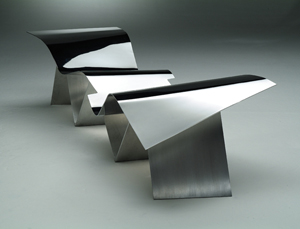
Best known for his successful and sometimes controversial architectural projects with sinuous metal facades, Gehry’s most iconic works are the Guggenheim Museum in Bilbao, Spain (1997) and the Walt Disney Concert Hall in Los Angeles (2003).
Before architecture, however, Gehry experimented with furniture design, a practice he continues when new ideas beg to be realized. Architects think in terms of materials, and he brings this sensibility to his furniture. His most recent piece, illustrated here, is a bench for two in tempered aluminum called Tuyomyo, which embodies all the grace of his architecture on a smaller scale.
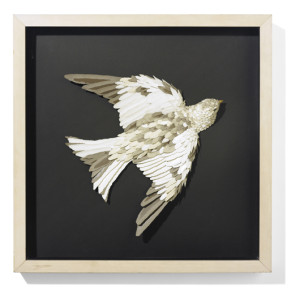
Gehry furniture was featured in US Design 1975-2000, a 2002-2004 exhibition which traveled from Denver to Miami, New York City and Memphis. The show was organized by R. Craig Miller, for many years curator of Architecture, Design and Graphics at the Denver Art Museum. He wrote in his catalog essay, “Gehry’s design approach is distinctive in two ways. Like some of the designers who celebrate the everyday, he consciously blurs the conventional lines between the fine and applied arts. … Like an artist, Gehry works with a hands-on method; his designs are fundamentally about a highly intuitive response to a material – whether cardboard or plastic laminate – that is transformed into a sculptural object and most often produced in limited numbers in a studio.”
Gehry was born in Canada in 1929 but moved to California in 1947, became a U.S. citizen, and graduated from the University of Southern California School of Architecture in 1954. Although only of a handful of early buildings had been completed, he was the winner of the prestigious Pritzker Prize for architecture in 1989. The foundation’s announcement notably stated: “In addition to his building designs, he has become widely known for his cardboard furniture concepts and for designing museum exhibitions.”
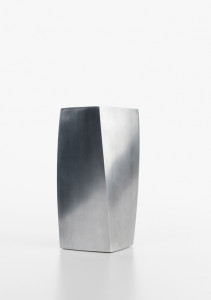
While paper products might seem unrelated to traditional construction materials, many designers experimented with reinforced cardboard furniture in the 1960s. Easily assembled and relatively lightweight, it fitted a peripatetic generation on the move from pad to pad. Gehry’s first 1969-1973 series, which he called Easy Edges, is formed with curving switchbacks of corrugated cardboard.
Miller noted: “Although constructed of cardboard rather than wood, the collection shows a clear extension of a Modernist aesthetic running from Thonet through Aalto: it relies on meticulously crafted laminated materials; it emphasizes its light structural frame; and it was intended to be an inexpensive product that could be produced in volume. However, the overnight success of this series overwhelmed Gehry, who was still struggling to establish his identity as an architect; and it was only some seven years later that he began to experiment with cardboard again, in the Experimental Edges furniture series of 1979-1982.”
“It is not the cardboard alone, though, but the extraordinary intuitive interplay between mass, material, construction and texture that marks Experimental Edges as perhaps Gehry’s most accomplished and original furniture design to date,” continued the curator. “The series also reflected his new status as a rising star and a darling of the media. While the Easy Edges series was mass-produced, modestly priced and retailed in department stores. Experimental Edges was handmade and sold through galleries as expensive, limited-edition art furniture.”
The aesthetic qualities outlined by Miller have made the cardboard designs favorites with collectors. Because of their mass production, Easy Edges constructions – chairs, lounges, stools, and tables – often turn up at auction for reasonable prices. Wright in Chicago has sold a rocking chair for $9,000 and a lounge chair for $1,900. A pair of cardboard “Wiggle Chairs” brought $1,300 at Treadway in Cincinnati, and the firm sold a dining table from the series for $1,700.
[/av_textblock]
[av_hr class=’invisible’ height=’50’ shadow=’no-shadow’ position=’center’ custom_border=’av-border-thin’ custom_width=’50px’ custom_border_color=” custom_margin_top=’30px’ custom_margin_bottom=’30px’ icon_select=’yes’ custom_icon_color=” icon=’ue808′ font=’entypo-fontello’]
[av_heading tag=’h3′ padding=’10’ heading=’“He consciously blurs the conventional lines between the fine and applied arts.”’ color=’custom-color-heading’ style=’blockquote classic-quote’ custom_font=’#020202′ size=’44’ subheading_active=” subheading_size=’15’ custom_class=”][/av_heading]
[av_hr class=’invisible’ height=’50’ shadow=’no-shadow’ position=’center’ custom_border=’av-border-thin’ custom_width=’50px’ custom_border_color=” custom_margin_top=’30px’ custom_margin_bottom=’30px’ icon_select=’yes’ custom_icon_color=” icon=’ue808′ font=’entypo-fontello’]
[av_textblock size=’16’ font_color=’custom’ color=’#686868′]
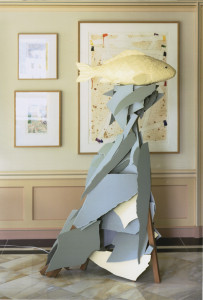
Working in other materials besides cardboard, Gehry has continued to invent designs that can be produced in quantity through furniture companies. Notable was the 1989 collection of bentwood furniture in curving laminated maple manufactured by Knoll. The group included the Cross Check Arm Chair, Face Off Cafe Table, Hat Trick Chair, High Sticking Chair and Power Play Chair and Ottoman.
Treadway Gallery sold two examples of the Cross Check for $800 each.
Once again for Knoll, Gehry created the 1999 FOG – the architect’s initials – stacking chair of cast aluminum covered in leather as well as a table with aluminum column, both intended for commercial use. A set of eight FOG chairs sold at Treadway in late 2007 for $2,700.
Frank Gehry’s works have entered the permanent collections of museums as well as private collections. For example, the Philadelphia Museum of Art owns Easy Edges examples, bentwood pieces by Knoll, and cubes of plastic resin designed in 2004. The furniture was on display in the exhibition Frank Gehry: Design Process and the Lewis House, which ran from November 2008 to April 2009.
While mass-produced Gehry pieces are affordable, unique commissions sell for far more. One of the most beautiful is the 1986 monumental illuminated conference table in six sections – pine and plastic laminate – originally created for an advertising firm in Venice, Calif. The table brought $169,000 at a December 2007 Phillips de Pury sale in New York.
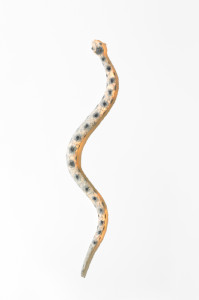
In addition, the architect created the aforementioned aluminum Tuyomyo bench, sold to benefit the Hereditary Disease Foundation research fund established in 2008 in honor of his late daughter, Leslie Gehry Brenner. The bench was executed in aluminum at Emeco in Hanover, Pa., a firm best known for the iconic Navy Chair, much admired by Gehry.
Emeco President Gregg Buchbinder says, “I know it wasn’t his intention to make it look like architecture – it just sort of happened that way. You can sit on it. It turned out the design ends up being for two people.”
He explains how the tempering process strengthens the metal without sacrificing portability: “The bench is amazingly light – it’s aluminum. It looks likes a very heavy sculptural piece but two people can easily pick the bench up. It weighs around 125 pounds. Where the ends of the bench cantilever out, it’s very strong so you can sit on it – it will no longer bend.”
James Zemaitis, head of 20th Century Design at Sotheby’s in New York, says, “When I first saw it, I said, this is like the Bilbao of furniture. … This is a unique work, a prototype for a long-range vision that Gehry and Emeco have about working with aluminum. It also has deep personal significance to Gehry in terms of his late daughter and raising money for the foundation.”
In addition to chairs and tables, Zemaitis points out, “In the late 1980s, he did a series of lamps that were done in limited editions – the Fish series. They were originally based on a Los Angeles restaurant interior that he did. Those Fish lamps are very valuable and have been where the auction records for Gehry furniture have been set up to this point.”
“The lamps are sculpture first and foremost,” he continues, and for that reason turn up in contemporary art sales. Sotheby’s set a world record for Gehry at auction when they sold a Fish lamp for $180,000 in November 2006. The architect also designed coiled and slithering snake lamps in the 1980s.
[/av_textblock]
[/av_one_full][/av_section][av_one_full first min_height=” vertical_alignment=’av-align-top’ space=” margin=’0px’ margin_sync=’true’ padding=’80px,40px,80px,40px’ border=’1′ border_color=’#eaeaea’ radius=’0px’ radius_sync=’true’ background_color=’#ffffff’ src=” attachment=” attachment_size=” background_position=’top left’ background_repeat=’no-repeat’]
[av_textblock size=” font_color=” color=”]
 About Karla Klein Albertson
About Karla Klein Albertson
Karla Klein Albertson focuses on the decorative arts, from excavated antiquities to contemporary pop-culture icons. She currently writes the Ceramics Collector column and exhibition features for Auction Central News, covers shows and auctions for the Maine Antique Digest, and authors the Antiques column in The Philadelphia Inquirer. She holds a master’s degree in classical archaeology from Bryn Mawr College.
[/av_textblock]
[/av_one_full]
[av_hr class=’invisible’ height=’50’ shadow=’no-shadow’ position=’center’ custom_border=’av-border-thin’ custom_width=’50px’ custom_border_color=” custom_margin_top=’30px’ custom_margin_bottom=’30px’ icon_select=’yes’ custom_icon_color=” icon=’ue808′ font=’entypo-fontello’]
[av_one_fifth first min_height=” vertical_alignment=” space=” custom_margin=” margin=’0px’ padding=’0px’ border=” border_color=” radius=’0px’ background_color=” src=” background_position=’top left’ background_repeat=’no-repeat’][/av_one_fifth]
[av_four_fifth min_height=” vertical_alignment=” space=” custom_margin=” margin=’0px’ padding=’0px’ border=” border_color=” radius=’0px’ background_color=” src=” background_position=’top left’ background_repeat=’no-repeat’]
[av_sidebar widget_area=’SCM – 728×90 – footer’]
[/av_four_fifth]


